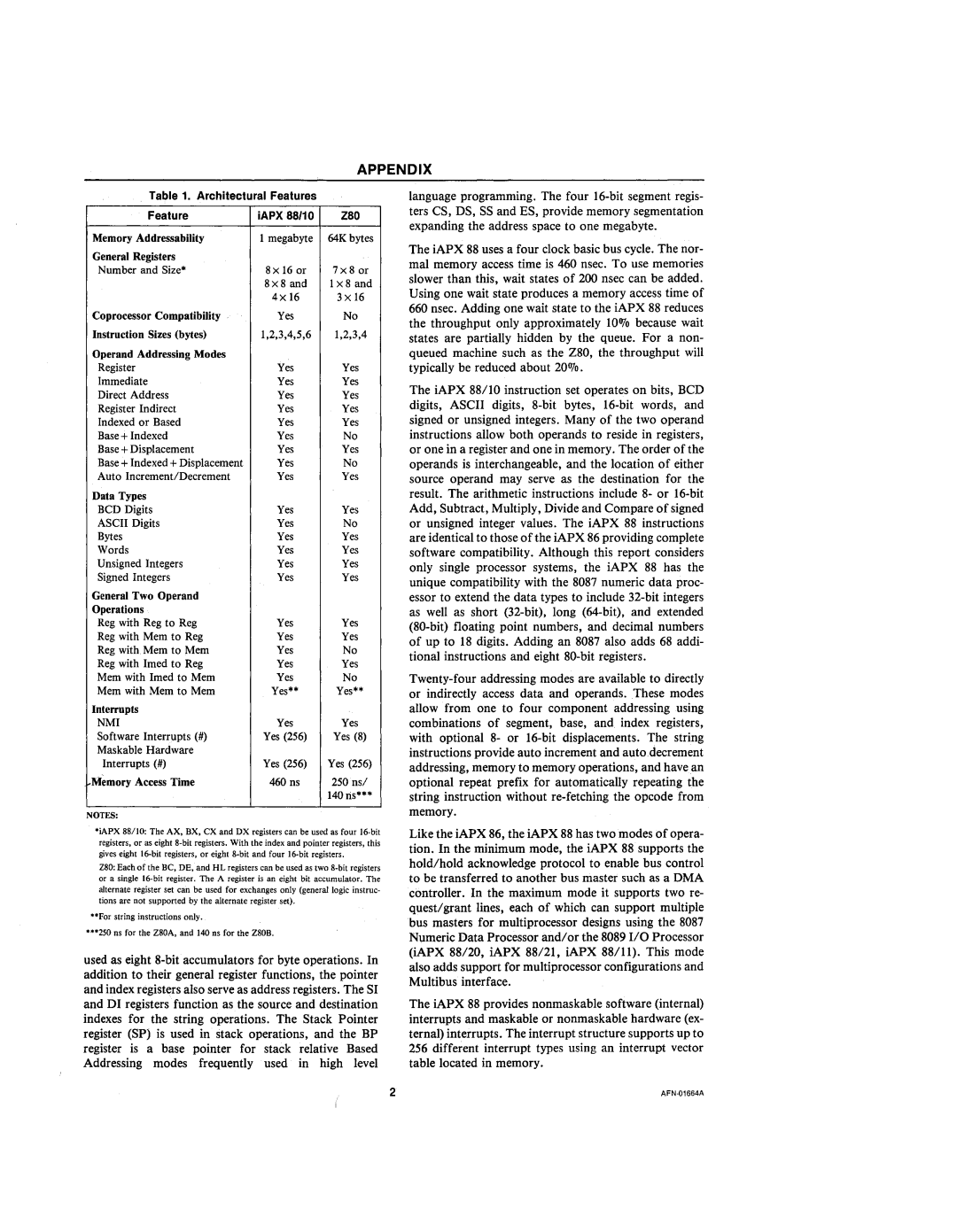
APPENDIX
Table 1. Architectural Features |
| |
Feature | iAPX88/10 | Z80 |
Memory Addressability | 1 megabyte | 64K bytes |
General Registers |
|
|
Number and Size· | 8x 16 or | 7x8 or |
| 8x8 and | 1x8 and |
| 4xl6 | 3x 16 |
Coprocessor Compatibility " | Yes | No |
Instruction Sizes (bytes) | 1,2,3,4,5,6 | 1,2,3,4 |
Operand Addressing Modes |
|
|
Register | Yes | Yes |
Immediate | Yes | Yes |
Direct Address | Yes | Yes |
Register Indirect | Yes | Yes |
Indexed or Based | Yes | Yes |
Base + Indexed | Yes | No |
Base + Displacement | Yes | Yes |
Base + Indexed + Displacement | Yes | No |
Auto Increment/Decrement | Yes | Yes |
Data Types |
|
|
BCD Digits | Yes | Yes |
ASCII Digits | Yes | No |
Bytes | Yes | Yes |
Words | Yes | Yes |
Unsigned Integers | Yes | Yes |
Signed Integers | Yes | Yes |
General Two Operand |
|
|
Operations, |
|
|
Reg with Reg to Reg | Yes | Yes |
Reg with Mem to Reg | Yes | Yes |
Reg with Mem to Mem | Yes | No |
Reg with Imed to Reg | Yes | Yes |
Mem with Imed to Mem | Yes | No |
Mem with Mem to Mem | Yes·· | Yes·· |
Interrupts |
|
|
NMI | Yes | Yes |
Software Interrupts (#) | Yes (256) | Yes (8) |
Maskable Hardware | Yes (256) | Yes (256) |
Interrupts (#) | ||
Memory Access Time | 460 ns | 250ns/ |
|
| 140 lis··* |
NOTES:
*iAPX 88/10: The AX. BX. ex and DX registers can be used as four
registers, or as eight
gives eight
Z80: Each of the BC, DE; and HL registers can be used as two
or a single
**For string instructions only..
"·250 os for the Z80A, and 140 ns for the ZSOB.
used as eight
language programming. The four
The iAPX 88 uses a four clock basic bus cycle. The nor- mal memory access time is 460 nsec. To use memories slower than this, wait states of 200 nsec can be added. Using one wait state produces a memory access time of 660 nsec. Adding one wait state to the iAPX 88 reduces the throughput only approximately 10DJo because wait states are partially hidden by the queue. For a non- queued machine such as the Z80, the throughput will typically be reduced about 20DJo.
The iAPX 88/10 instruction set operates on bits, BCD digits, ASCII digits,
Like the iAPX 86, the iAPX 88 has two modes of opera- tion. In the minimum mode, the iAPX 88 supports the hold/hold acknowledge protocol to enable bus control to be transferred to another bus master such as a DMA controller. In the maximum mode it supports two re- quest/grant lines, each of which can support multiple bus masters for multiprocessor designs using the 8087 Numeric Data Processor and/or the 8089 I/O Processor (iAPX 88/20, iAPX 88/21, iAPX 88/11). This mode also adds support for multiprocessor configurations and Multibus interface.
The iAPX 88 provides nonmaskable software (internal) interrupts and maskable or nonmaskable hardware (ex- ternal) interrupts. The interrupt structure supports up to 256 different interrupt types using an interrupt vector table located in memory.
2 |
